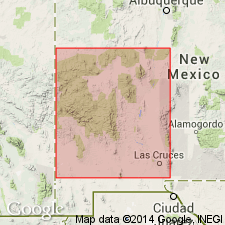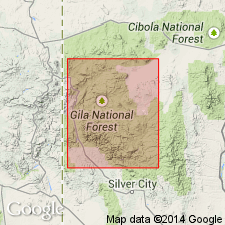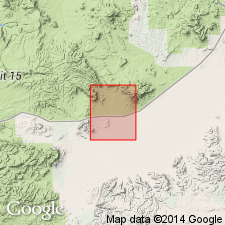
- Usage in publication:
-
- Datil Well Tuff
- Modifications:
-
- Original reference
- Dominant lithology:
-
- Tuff
- AAPG geologic province:
-
- Basin-and-Range province
Summary:
The Datil Well Tuff of the Datil Group, here named, is in the Datil Mountains and northern Jornada del Muerto, southwestern New Mexico. Consists of purple to pink, densely welded, moderately crystal-rich, rhyolite ash-flow tuff. Overlies the andesite of White House Canyon, an informal member of the Spears Formation, or the Dog Springs Member (new name) of the Spears; splits and is interbedded with the Chavez Canyon Member (new name) of the Spears; underlies the Rock House Canyon Tuff (new name) of the Datil Group. Thickness at the type section is 31.5 ft. Age is Oligocene based on fission-track and potassium-argon dates (36.7 Ma).
Type section: northeast side of White House Canyon across U.S. Highway 60 from the Datil Well Campground, 1.2 mi northwest of the junction of U.S. Highways 60 and 12 in the town of Datil, in NW/4 SW/4 sec. 2, T. 2 S., R. 10 W., Datil 7.5-min quadrangle, Catron Co., NM.
Source: US geologic names lexicon (USGS Bull. 1565, p. 82).

- Usage in publication:
-
- Datil Well Tuff
- Modifications:
-
- Geochronologic dating
- AAPG geologic province:
-
- Basin-and-Range province
Summary:
Has yielded an age of 35.6 +/-1.3 m.y. (sanidine) and 37.7 +/-3.8 m.y. (zircon), Datil quad, and of 35.51 m.y. (40Ar/ 39Ar) Catron Co, NM, Basin-and-Range province.
Source: GNU records (USGS DDS-6; Denver GNULEX).

- Usage in publication:
-
- Datil Well Tuff*
- Modifications:
-
- Overview
- Geochronologic dating
- Paleomagnetics
- AAPG geologic province:
-
- Basin-and-Range province
Summary:
Is formation in Datil Group. Is mapped in Horse Mountain West Quadrangle, Catron Co, NM, in eastern part of Basin-and-Range province. Is light-gray to light-pinkish-brown, densely welded ash-flow tuff; contains as much as 15 percent small phenocrysts, mainly sanidine (1-3 mm), minor to a trace of green clinopyroxene, plagioclase, biotite and opaque oxide, and rare quartz, brown hornblende or allanite, zircon, and apatite in a vitroclastic to granophyric matrix. Scattered lithic fragments are mostly brown andesitic rocks. Lack, or near lack of plagioclase may help to distinguish from overlying tuff of Farr Ranch. The two units may be separated from a few meters of volcaniclastic conglomerate, and only than can the two units be easily distinguished. Thickness is 0 to about 10m. Natural remanent magnetism determined as follows: mean inclination, 51.6; mean declination, 17.6; polarity, normal. Isotopic dating: 40 Ar/39 Ar age is 35.41 Ma, Oligocene.
Source: GNU records (USGS DDS-6; Denver GNULEX).
For more information, please contact Nancy Stamm, Geologic Names Committee Secretary.
Asterisk (*) indicates published by U.S. Geological Survey authors.
"No current usage" (†) implies that a name has been abandoned or has fallen into disuse. Former usage and, if known, replacement name given in parentheses ( ).
Slash (/) indicates name conflicts with nomenclatural guidelines (CSN, 1933; ACSN, 1961, 1970; NACSN, 1983, 2005, 2021). May be explained within brackets ([ ]).

